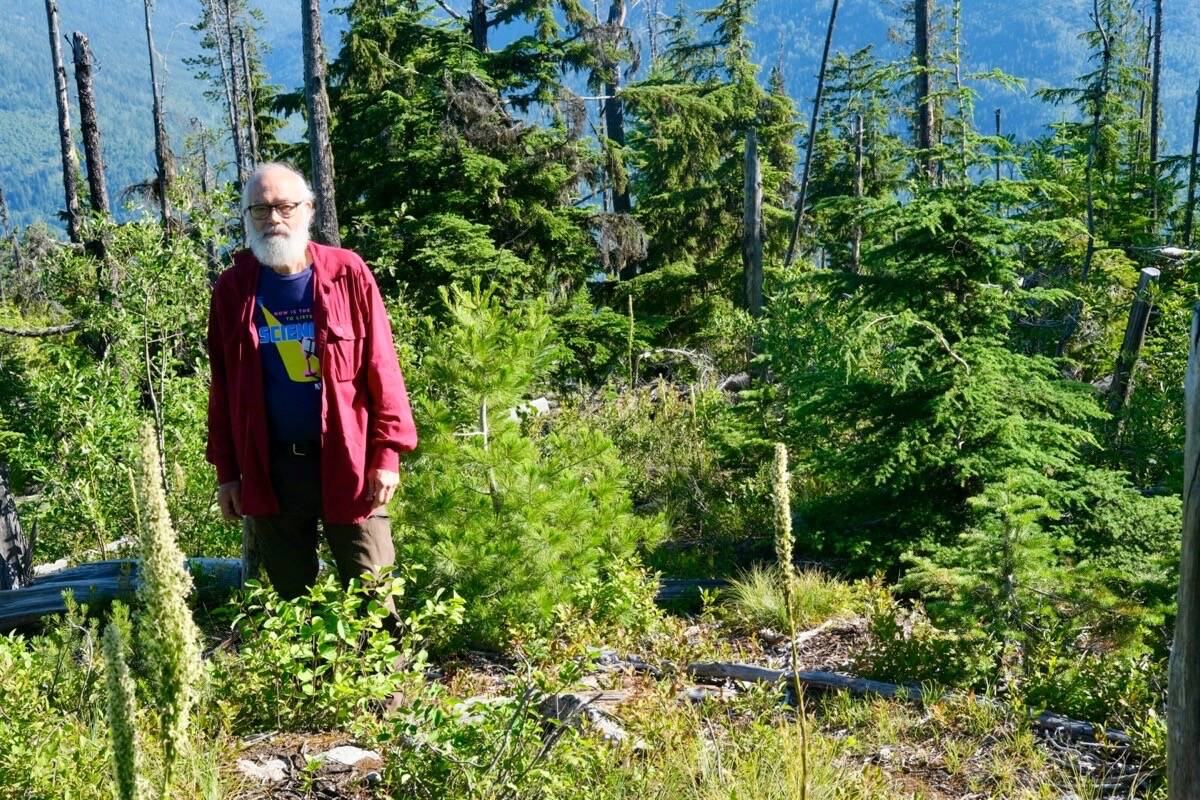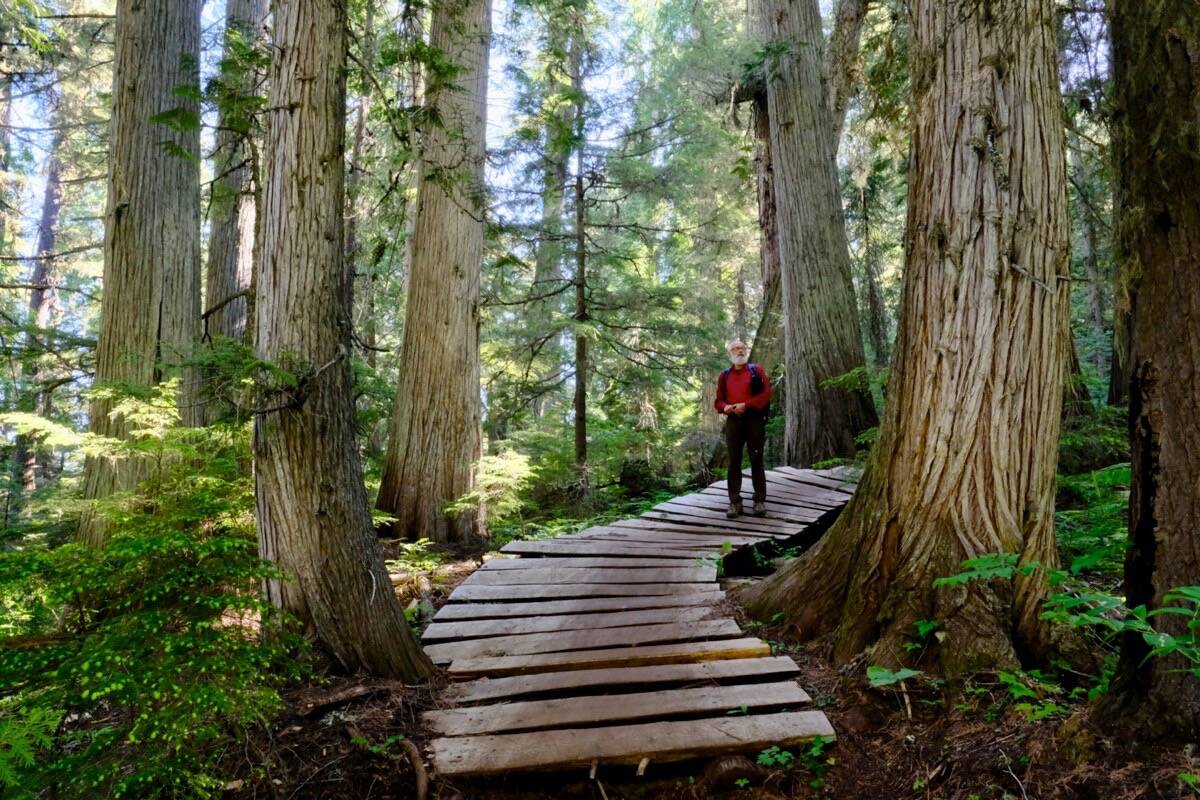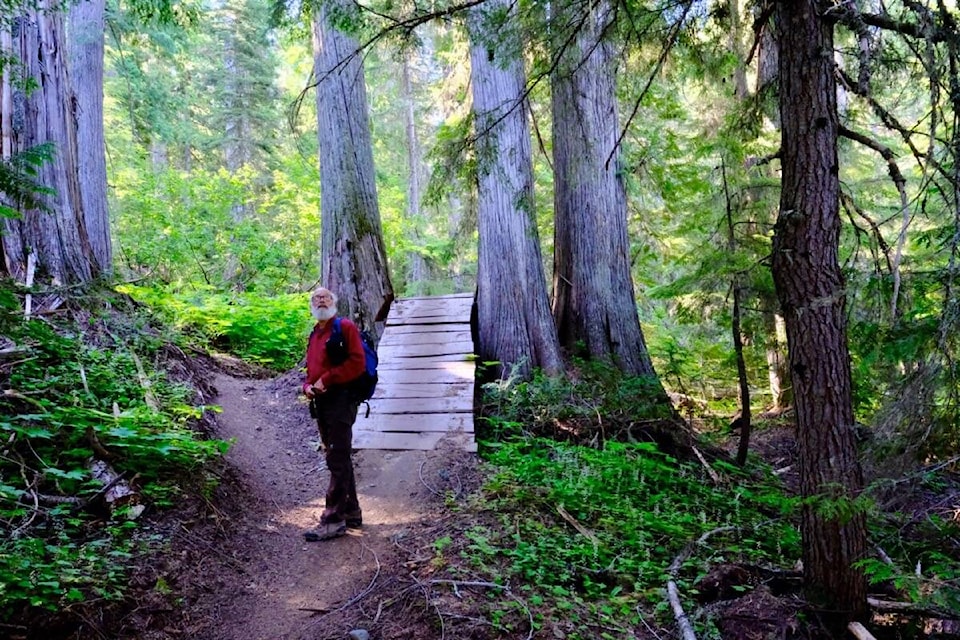A few kilometres up Giveout Creek Road near Nelson, ecologist Greg Utzig stands dwarfed beside a tall grove of old growth hemlock and cedar.
The grove, he says, is a remnant of a much larger stand of several hundred hectares that has been logged over the years since the 1980s down to its current one hectare.
“This was all growth,” says Utzig, gesturing toward the logged area. “There were a couple little ponds in there. It would have been a spectacular area.”
That logged forest was never included in a provincial Old Growth Management Area (OGMA). It was logged as part of the conventional timber supply, and the small remainder of the old trees could be logged too, without any discussion of protection.
Down the road a couple of kilometres, Utzig points out a forest area sparsely populated with small trees, logged about 35 years ago. It is typical, Utzig says, of some forests that are protected in an OGMA even though there are no big trees in sight.
Utzig says in the Kootenays there are significant numbers of old growth trees that are unprotected, and many non-old growth forests that are protected. It’s been like this for since the 1990s, Utzig says, and he sees no sign of change.
Forests ministry response
No one at the Ministry of Forests, locally or at the provincial level, was willing to be interviewed on this apparent contradiction. But a ministry spokesperson said in an email that the calculation of old growth targets in the Kootenays is “aspatial,” meaning that the amount of old growth is calculated as a percentage of the total forest across large parts of the landscape, not as lines on a map.
“It is inaccurate to say that there are a significant number of OGMAs that contain no old growth,” the email states. “It is correct that many OGMAs contain more mature forests than old growth. However, mature forests were included in OGMAs to capture larger, more contiguous areas.”
Utzig, who has spent decades doing scientific work in West Kootenay forests, disagrees, stating that there are many OGMAs with little or no old growth and that the ministry’s own data bears this out.
“What I am concerned about is OGMAs that are poor quality unproductive stands in gullies, on steep slopes and in subalpine areas, while nearby there are high quality old forests,” he says. “These OGMAs are not high quality old growth or even mature stands, they are just places where no one wants to log.”

Asked if there is old growth that is not in OGMAs, the ministry states in its email, “Yes. However it is important to note that old forests protection includes several other designations and is not limited to just OGMAs.”
What those designations are was not explained, but Utzig says the old growth he is talking about is included in the timber harvesting land base, with no protection.
The email goes on to say that the ministry is working on a process to include more old growth forests in OGMAs. Asked about the timeline for this work, the ministry spokesperson was unspecific.
“Timelines for this work would be significant.”
Ecology vs. timber
Nelson scientist Rachel Holt she says government and industry know how to fix the OGMAs if they wanted to, adding that logging of old growth should be stopped until that planning is done.
She was a member of the province’s Technical Advisory Panel on Old Growth in 2021, and has also served as vice chair of the Forest Practices Board.
Holt says a 2018 forests ministry report showed that only about 20 per cent of the OGMAs in Kootenay Lake and Arrow forest districts were actually old growth, and that in many places old growth existed outside the OGMAs but was not protected. That report can be found at .
The ministry’s email does admit to problems identifying old growth.
“Small patches of old growth can be a challenge for forest inventory interpretation due to scale constraints of the dataset. Important work continues to better identify old growth forests.”
Holt says the ministry does not seem to be constrained by “scale constraints of the dataset” when it comes to finding harvestable timber.
“Yes, there are scale issues,” Holt says. “But I can tell you that when someone walks up to a 400-year-old cedar tree around here, which there aren’t very many of, they know what it is. We can blame the inventory as much as they like, but we’re very good at finding and harvesting big old growth.”
Holt says the current provincial approach to implementing OGMAs leads to logging in areas that “should not have been logged, by any kind of basic ecological criteria.”
Moveable boundaries
Back on the ground at Giveout Creek, standing under that patch of old growth, Utzig says the boundaries of the OGMAs are fluid and can be moved by forest managers to include or exclude forest depending on its harvest value. This accords with the ministry’s description of the old growth that is in OGMAs as “aspacial,” meaning not mapped.
He adds that managers can do this because of the professional reliance model, instituted in the early 2000s, in which resource companies or their professional consultants can make land use decisions formerly reserved for ministry scientists, including changing the boundaries of OGMAs.
The ministry email says anything taken out of an OGMA for harvesting must be replaced by forest of equal or greater value, that this decision is made by a professional, and the rationale must be documented by the timber company.

Holt agrees that the ministry has been asking more often for such rationales from timber companies in the past two years as a result of public pressure, but for 15 years before that they did not. She adds that the OGMAs have never been evaluated according to biological criteria but instead by timber harvest criteria, which resulted in some OGMAs being put into parks or places that were not going to be logged in any event.
A 1990s land use plan
The history of all this, according to Utzig, goes back to the 1990s, when a land use plan was developed for the Kootenays that specified certain percentages of old growth to be retained. But before it was implemented, he says the government of the day decided the percentages would have too great an impact on the timber harvest. So they decided that a third of the original percentages would be enough.
For many areas in the West Kootenay the reduced requirements amounted to around three per cent of the forests to be preserved as old growth.
“But the fact is,” Utzig says, “they aren’t even meeting that three per cent now. That’s the problem.”
Holt has been working on old growth issues in B.C. for more than 20 years.
“In my very first job (for the forest ministry) in 1997,” she says, “I flew every single landscape unit in the Kootenay-Boundary and East Kootenay, the whole southern region, and identified the best OGMAs, the best old growth out there from the air with ministry staff. And the vast majority of that was never included. And what we did see was this egregious move to just putting OGMAs in places that didn’t impact timber supply.”
In 2021 the province contracted with Holt, along with forest policy analyst Lisa Matthaus, ecologist Karen Price, landscape analyst Dave Daust, and forester Garry Merkel, to map the province’s old growth, to places where logging would pose a short-term threat of irreversible biodiversity loss. Holt says she is for the province to act decisively on her work.
In addition to those maps, Holt and Utzig independently mapped Kootenay old growth, using provincial data.
“What we considered was age, height, diameter, gross volume, and site productivity. All those factors were used to rate these stands from most valuable growth to least valuable.”
Those maps can be viewed at .
Even if Holt and Utzig identified an area in the Kootenays as old growth, they say this does not mean it is protected from logging, because it might not be in an OGMA.
Even if it were, the boundaries of the OGMA can be changed by government or industry.
READ MORE:
•
•
•
www.facebook.com



